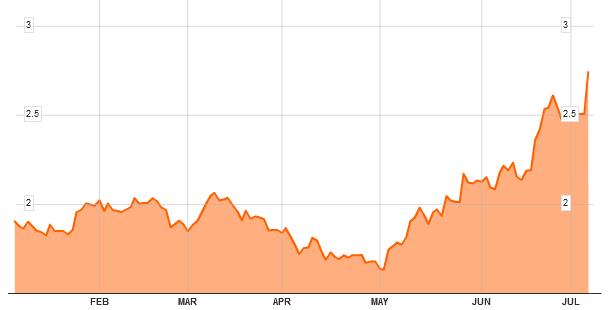Member LoginDividend CushionValue Trap |
The 10-year Treasury Yield Keeps Rallying
publication date: Jul 6, 2013
|
author/source: Brian Nelson, CFA
The 10-year Treasury yield jumped an impressive 22 basis points during trading Friday to end the session at 2.73%. We continue to monitor changes in this important benchmark rate because it impacts the decisions of income investors, the financial performance of equities levered to spread income (and often their book values), and the risk-free rate we use in our discounted cash-flow valuation models. US Generic Govt 10 Year Yield
Image Source: Bloomberg The risk free rate we use in our valuation models is a weighted average of the long-term historical average of the 10-year Treasury and the current spot rate of the 10-year Treasury. We update the discount rate systematically across our coverage universe periodically when material changes warrant such action (+/- one percentage point). Though we note the rapid rise of the benchmark rate in recent weeks, we are maintaining our 4.25% risk-free rate assumption in our valuation framework at this time. The updated calculation, which considers both the long-term Treasury rate and the current spot rate, is still approximately 4%. The long-term average of the 10-year Treasury rate remains comfortably north of 6% and is more heavily weighted in the computation. Q: Why do you use a risk free rate assumption of 4.25% when the current spot rate of the 10-year Treasury is about 2%? In our discounted cash-flow models that we use to value every non-financial operating company in our coverage universe, we match the duration of future free cash flows (from year 1 to perpetuity) with expectations of the average discount rate over this forecast horizon (from year 1 to perpetuity). We think the best way to achieve expectations of the long-term future average rate of the 10-year Treasury (risk free rate) is to use the weighted average of the historical 10-year Treasury and the current spot rate. The goal of using a weighted average risk free rate in our DCF process is to achieve balance with respect to the duration of future cash flows. For example, discounting a cash flow in Year 20 at the current spot rate doesn’t make much sense to us. Other methods consider the yield curve in discounting future free cash flows, or use a long-term average of the risk free rate without considering near-term changes in the 10-year Treasury rate. We think the use of the spot rate on the 10-year Treasury as the risk free rate in any valuation model would not only cause significant fair-value volatility but also result in a systematic overvaluation of companies relative to their true long-term intrinsic worth. Related ETFs: PIMCO 1-3 Year US Treasury Index ETF (TUZ), iShares 1-3 Year Treasury Bond ETF (SHY), Vanguard Short-Term Government Bond Index ETF (VGSH), iShares 20+ Treasury Bond ETF (TLT), iShares 3-7 Treasury Bond ETF (IEI), PIMCO 3-7 Year US Treasury Index ETF (FIVZ), ProShares UltraShort 20+ Year Treasury ETF (TBT) |


